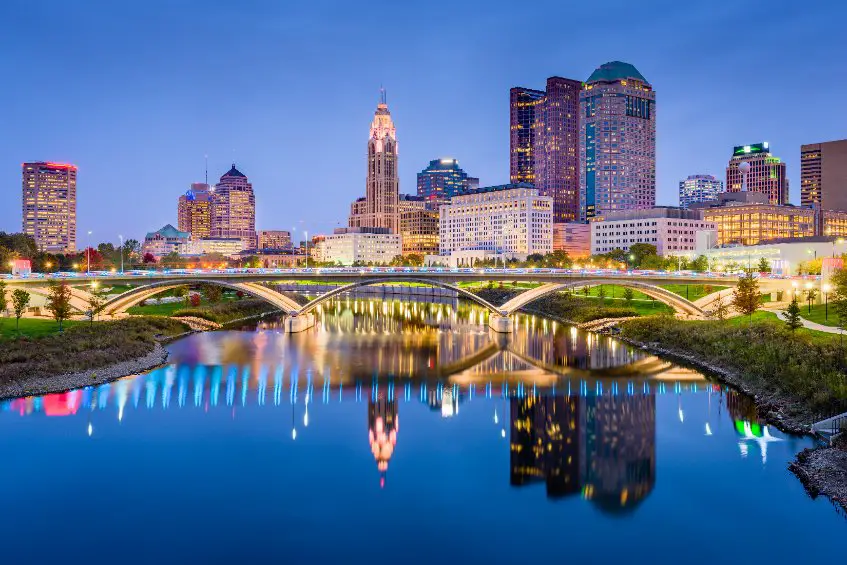
Liberal goals and perspectives center around individual rights and legal equality in addition to social progressivism and the promotion of social welfare. How “liberal” a place is can often be determined by the elected officials, population demographics, and public opinion surrounding a specific topic, but it can just as often be determined by comparing specific concerns to other locations, be they similar in size, population, or geographical location.
Columbus, Ohio is a liberal city. The majority of its elected city officials are Democrats and it has no specific laws that drastically impact at-risk populations. The attitude of its citizens towards women and minorities is positive, though it struggles to pass more liberal legislation.
Gun control and abortion are two hot-button topics in the current political climate, so those will be discussed specifically, but the rest of this article will look at different elements that are in play when determining how liberal or conservative a place is.
Elected Officials
The city government of Columbus includes seven City Council members, a Mayor, a City Auditor, and a City Attorney that are elected and serve in four-year terms.
The election of the mayor in Columbus is officially nonpartisan, but the current mayor, Andrew Ginther, has Democratic affiliations. He was originally elected in 2015 and reelected in 2019, carrying almost 94% of the vote. The City Council, while also officially nonpartisan, has Democratic affiliations among most of its members. Additionally, the City Auditor, Megan Kilgore, and the City Attorney, Zach Klein, are also Democrats.
Gun Control

There aren’t any laws specific to Columbus individually, though the City Council has proposed a set of Common Sense Gun Laws , though they haven’t been ruled on. The mayor of Columbus, Andrew Ginther, recently declared
, though they haven’t been ruled on. The mayor of Columbus, Andrew Ginther, recently declared gun violence to be a public health crisis, and the city’s population seems to be in favor of gun control.
gun violence to be a public health crisis, and the city’s population seems to be in favor of gun control.
Ohio as a state has allowed the concealed carrying of weapons since 2004. Generally, other changes in Ohio gun laws since then have been to expand the rights of gun owners.
since then have been to expand the rights of gun owners.
Most recently, Governor Mike DeWine signed a “Stand Your Ground” law in 2021 that allowed Ohioans to use deadly force (ie, their gun) in a public place without first trying to retreat, and in 2022 he signed a bill eliminating the need for a background check and training course as prerequisites to obtaining a concealed carry permit.
On June 1, 2022, both the Ohio Senate and House passed a bill that allows teachers to carry guns in school with consent from a board and just 24 hours of training unless the board requires more.
that allows teachers to carry guns in school with consent from a board and just 24 hours of training unless the board requires more.
Though the city itself has specific gun laws that better enforce or inhibit existing state gun laws, the general attitude of citizens and elected officials suggests that it has a more liberal view of gun control compared to the rest of the state.
Abortion
Abortion is currently legal in Ohio. According to the Guttmacher Institute , as of May 2022, the following restrictions on abortion access were in place:
, as of May 2022, the following restrictions on abortion access were in place:
- The patient must receive counseling and wait 24 hours after initially contacting the doctor before the procedure will take place.
- State health plans under the ACA will only cover the cost of abortion when the pregnancy is life-endangering or caused by rape or incest.
- The insurance policies for public employees also only cover abortion costs when the mother’s life is in danger or the pregnancy is caused by rape or incest.
- Medication that causes abortion has to be administered through FDA protocol.
- Minors must receive a parent’s consent before they can get an abortion.
- Public funding for abortion is only available in instances of life-endangerment, rape, or incest.
- Most patients are required to have an ultrasound before their procedure, as the provider must test for a fetal heartbeat, and are given the option to see the image.
- An abortion past 20 weeks may only occur in casts of life-endangerment or severely compromised health.
- Abortions sought in response to genetic anomalies are prohibited.
- Many abortion clinics have to meet state requirements regarding their staff, equipment, and place of business.
Based on these restrictions, though abortion is legal in the state, the policies surrounding it are still conservative. There isn’t much data about Columbus in particular, as public opinion surrounding abortion is split .
.
Voting Accessibility
Voting accessibility is directly impacted by how easy it is to register, any identification needed to vote, and polling locations. Here are Ohio’s voting laws :
:
- To register to vote in Ohio, the applicant has to be a US citizen, have lived in Ohio for 30 days prior to the election, and have turned 18 before the election as well. People in incarceration, declared by a court to be incompetent to vote, or permanently disenfranchised (convicted of two or more felonies) might not be able to register to vote. A person can register to vote online, in person, or by mail. Registration to vote is allowed up to 30 days before the election.
- Voters are required to show ID if they decide to vote in person. Absentee ballots must be requested 90 days before the election. Early voting is permitted.
- Election-day registration isn’t allowed. All polling locations are open from 6:30 am to 7:30 pm.
73.99% of registered voters in Ohio turned out for the general election in November of 2020.
of registered voters in Ohio turned out for the general election in November of 2020.
As voting is one of the primary ways average citizens can engage in government, places with greater voting accessibility have a more liberal stance on voting rights. Though legally, everyone in the United States over the age of 18 is allowed to vote, there are measures in place to prevent voter fraud and ensure voting is limited to legal US citizens. Often, these protective policies can be taken to extremes in order to limit who is able to vote so certain officials and politicians receive the outcome they were hoping for.
in order to limit who is able to vote so certain officials and politicians receive the outcome they were hoping for.
Minimum Wage
While it may seem an out-of-the-box choice on issues that lean liberal or conservative, minimum wage impacts low-income workers and those at the lower end of the economic scale. Increasing the minimum wage would increase their earnings and give them more opportunities to influence their lives for the better in other areas.
Having more access to money directly impacts housing options, insurance options, transportation, education, and medical expenses for lower-earning communities. With an increase in earnings, the gap between the poor and the wealthy gets smaller, and equality across the population increases.
The minimum wage in Ohio is $9.30 per hour . The Federal minimum wage is $7.25 per hour. The highest statewide minimum wage
. The Federal minimum wage is $7.25 per hour. The highest statewide minimum wage is $15.20 in the District of Columbia, while some local minimum wage rates are as high as $17.53 per hour.
is $15.20 in the District of Columbia, while some local minimum wage rates are as high as $17.53 per hour.
The lowest minimum wage in the country is the Federal minimum wage, which 21 states meet. Again, Columbus doesn’t have any laws in particular that impact minimum wage in specific ways, so using Ohio’s minimum wage, Columbus has a more liberal stance on minimum wage than almost half the other states, but it doesn’t have a minimum wage as high as other, more liberal cities.
Racial, Gender, and LGBT+ Equality

The progressivism of a place is often tied to population. Those that more progressive governance would directly benefit tend to vote for and support lawmakers that help create progressive legislation.
As women, people of color, and LGBT+ communities have historically benefited from civil rights movements, living in places with larger populations that fall into these groups will directly impact whether the social atmosphere is more liberal or not.
58.64% of the Columbus population is White, 28.99% are Black, 5.82% are Asian, 4.15% are of two or more races, 2.09% are of the ambiguous other race, 0.27% are Native American, and 0.04% are Native Hawaiian or Pacific Islander.
is White, 28.99% are Black, 5.82% are Asian, 4.15% are of two or more races, 2.09% are of the ambiguous other race, 0.27% are Native American, and 0.04% are Native Hawaiian or Pacific Islander.
Concerning police brutality, 53% of arrests made in Columbus are of Black citizens and 42% are of White citizens; 73% of people killed by police in Columbus were Black and 25% were White, and there was more force used per arrest than 94% of other surveyed departments.
Women make $0.79 to a man’s dollar in Ohio, with Black women making $0.64 and Latinx women making $0.61. Comparatively, the national figures are $0.82, $0.63, and $0.54. 13.8% of women living in Ohio live in poverty, with 12.0% being the national number; 41.1% compared to 35.6% of single mothers in Ohio live in poverty.
make $0.79 to a man’s dollar in Ohio, with Black women making $0.64 and Latinx women making $0.61. Comparatively, the national figures are $0.82, $0.63, and $0.54. 13.8% of women living in Ohio live in poverty, with 12.0% being the national number; 41.1% compared to 35.6% of single mothers in Ohio live in poverty.
A study done by the Women’s Fund of Central Ohio published in June 2016 shows 1 in 6 elected statewide executives is a woman, 10 of 53 cities in Central Ohio have female mayors (Columbus isn’t one of these), 27 out of 99 Ohio House representatives and 3 out of 16 Ohio Congressional representatives are women, and 1 in 10 CEO and Executive Board positions are held by women.
done by the Women’s Fund of Central Ohio published in June 2016 shows 1 in 6 elected statewide executives is a woman, 10 of 53 cities in Central Ohio have female mayors (Columbus isn’t one of these), 27 out of 99 Ohio House representatives and 3 out of 16 Ohio Congressional representatives are women, and 1 in 10 CEO and Executive Board positions are held by women.
Another report by the Women’s Fund of Central Ohio shows there isn’t an established health education standard in K-12 schools.
by the Women’s Fund of Central Ohio shows there isn’t an established health education standard in K-12 schools.
The Human Rights Campaign’s Municipality Equality Index gave Columbus a score of 100 on a scale of 100. It shows there are sufficient laws in place to prohibit discrimination on the basis of sexual orientation and gender identity concerning employment, housing, and public accommodations, as well as protecting LGBT+ youth from conversion therapy.
gave Columbus a score of 100 on a scale of 100. It shows there are sufficient laws in place to prohibit discrimination on the basis of sexual orientation and gender identity concerning employment, housing, and public accommodations, as well as protecting LGBT+ youth from conversion therapy.
It also shows the city provides transgender-inclusive healthcare benefits, has a city contractor non-discrimination ordinance, and provides city employee domestic partner benefits. Beyond the legal protections toward the queer community, there have been regular Pride events happening in the city since 1982 , and 4.3%
, and 4.3% of the population identifies as part of the LGBT+ community.
of the population identifies as part of the LGBT+ community.
Columbus is a more liberal city regarding its population demographics. There’s a positive attitude toward LGBT+ citizens and women’s issues, though the majority of the population is white and it does have problems with police brutality.
Immigration
A report by the Vera Institute of Justice shows that 10% of the total population in Columbus are immigrants, around 155k people. Around 81k non-citizens in Columbus are at risk of deportation. 70% of the immigrant population participate in the workforce in Columbus compared to 68% of the city’s native-born population.
by the Vera Institute of Justice shows that 10% of the total population in Columbus are immigrants, around 155k people. Around 81k non-citizens in Columbus are at risk of deportation. 70% of the immigrant population participate in the workforce in Columbus compared to 68% of the city’s native-born population.
Though Columbus doesn’t have the title of “sanctuary city,” it acts like one in many ways, particularly in not holding inmates past their release dates in order for ICE to detain them.
in many ways, particularly in not holding inmates past their release dates in order for ICE to detain them.
Related Topics:
If you like the article above, here are some other similar articles you should check out!
Is There Public Transportation in Columbus, Ohio?
